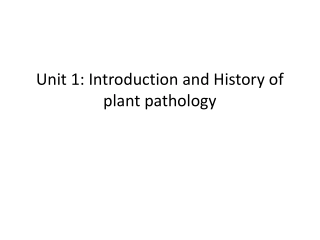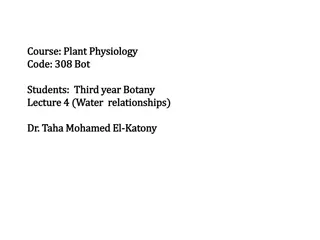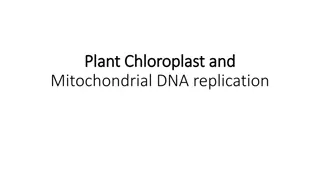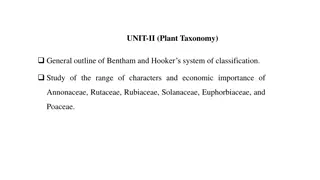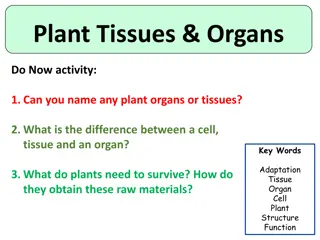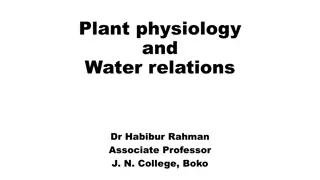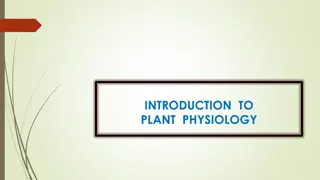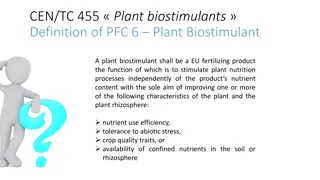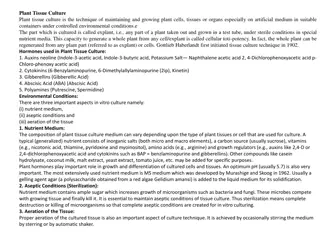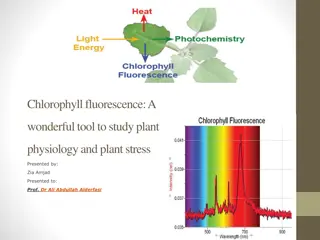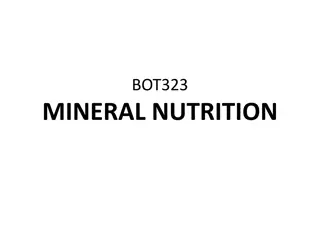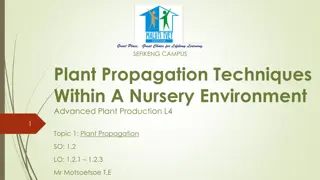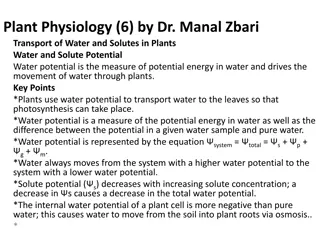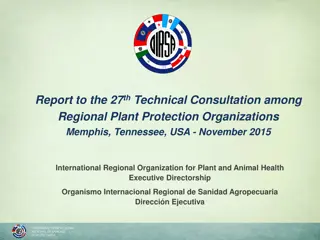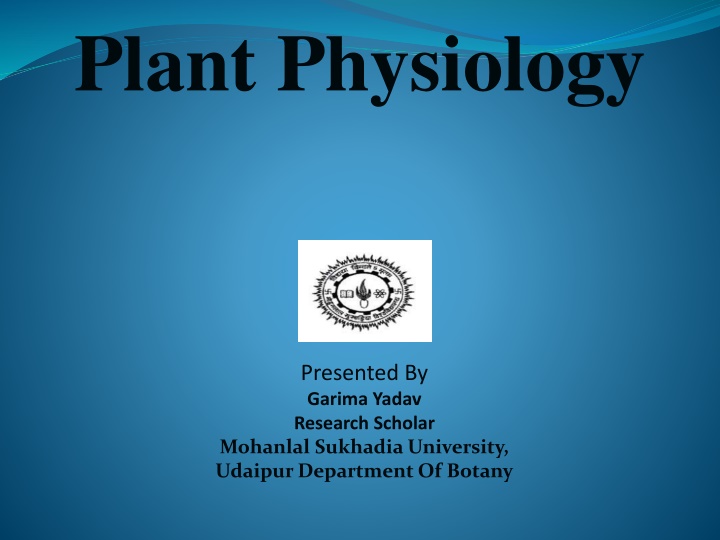
Fascinating Insights into Gibberellins: Plant Hormones Revealed
Delve into the captivating world of gibberellins, a group of plant hormones pivotal in stem growth and various physiological processes. Discover their history, biosynthesis, and significant impact on plant development, as elucidated by pioneering research. Uncover the intriguing origins of gibberellins, their role in inducing plant elongation, and the groundbreaking experiments that unveiled their powerful effects on plant growth. Explore the intricate chemical structure and biological activities of gibberellins, shedding light on their profound influence in plant physiology.
Download Presentation

Please find below an Image/Link to download the presentation.
The content on the website is provided AS IS for your information and personal use only. It may not be sold, licensed, or shared on other websites without obtaining consent from the author. If you encounter any issues during the download, it is possible that the publisher has removed the file from their server.
You are allowed to download the files provided on this website for personal or commercial use, subject to the condition that they are used lawfully. All files are the property of their respective owners.
The content on the website is provided AS IS for your information and personal use only. It may not be sold, licensed, or shared on other websites without obtaining consent from the author.
E N D
Presentation Transcript
Plant Physiology Presented By Garima Yadav Research Scholar Mohanlal Sukhadia University, Udaipur Department Of Botany
Gibberellins In the 1950s the second group of hormones, the gibberellins (GAs), was characterized. The gibberellins are a large group of related compounds (more than 125 are known) that, unlike the auxin, are defined by their chemical structure rather than by their biological activity. Gibberellins are most often associated with the promotion of stem growth, and the application of gibberellins to intact plants can induce large increases in plant height. As we will see, however, gibberellins play important roles in a variety of physiological phenomena. The biosynthesis of gibberellins is under strict genetic, developmental, and environmental control, and numerous gibberellin-deficient mutants have been isolated. Mendel s tall/dwarf alleles in peas are a famous example.
Although gibberellins did not become known to American and British scientists until the 1950s, they had been discovered much earlier by Japanese scientists. Rice farmers in Asia had long known of a disease that makes the rice plants grow tall but eliminates seed production. In Japan this disease was called the foolish seedling, or bakanae, disease. Plant pathologists investigating the disease found that the tallness of these plants was induced by a chemical secreted by a fungus that had infected the tall plants. This chemical was isolated from filtrates of the cultured fungus and called gibberellin after Gibberella fujikuroi, the name of the fungus. In the 1930s Japanese scientists succeeded in obtaining impure crystals of two fungal growth-active compounds, which they termed gibberellin A and B. At about the same time scientists at Tokyo University isolated three gibberellins from the original gibberellin A and named them gibberellin A1, gibberellin A2, and gibberellin A3. Gibberellin A3 and gibberellic acid proved to be identical. As gibberellic acid became available, physiologists began testing it on a wide variety of plants. Spectacular responses were obtained in the elongation growth of dwarf and rosette plants, particularly in genetically dwarf peas (Pisum sativum), dwarf maize (Zea mays), and many rosette plants.
Gibberellins, like auxin, are also growth-promoting compounds which are active at low concentrations. They were first isolated from the rice fungal pathogen Gibberella fujikuroi, which causes infected plants to grow very tall, and it was only later that related compounds were isolated from healthy plants. Gibberellins are synthesized primarily in the apical tissues and young leaves. It is uncertain whether root tissues also produce gibberellins. The highest levels of gibberellins are found in immature seeds and developing fruits. Gibberellins are synthesized by the condensation of four isoprenoids subunits. The basic biological isoprene unit is isopentenyl pyrophosphate (IPP). IPPs condense to produce 20 carbons geranylgeranyl pyrophosphate (GGPP). GGPP acts as a biosynthetic precursor for gibberellins. As more and more gibberellins from fungal and plant sources were characterized, they were numbered as gibberellin AX (or GAX), where X is a number, in the order oftheir discovery. This scheme was adopted for all gibberellins in 1968
Certain commercial chemicals block the synthesis of gibberellins. Some of these chemicals are Phosphon D, AMO-1618, Cycocel (CCC), ancymidol, and paclobutrazol. These chemicals inhibit the first stage of gibberellin biosynthesis. Gibberellins are translocated via the phloem and xylem. The gibberellins that are synthesized in the shoot are transported to the rest of the plant via the phloem. The presence of gibberellins in root exudates and root extracts supports the synthesis of gibberellins in roots. The gibberellins that are synthesized in the root are transported to the shoot via the xylem. The movements of gibberellins in plants do not exhibit polarity like auxins. Gibberellins are capable of moving both up and down the stem..
Physiological Effects Though Gibberellins were originally discovered as the cause of a disease of rice that stimulated internodes elongation, endogenous gibberellins influence a wide variety of developmental processes. In addition to stem elongation, gibberellins control various aspects of seed germination, including the loss of dormancy and the mobilization of endosperm reserves. In reproductive development, gibberellin can affect the transition from the juvenile to the mature stage, as well as floral initiation, sex determination, and fruit set Application of different concentrations of GA to these plants causes internodes elongation, and this was used as a bioassay for these compounds for many years. GA have been demonstrated to have many roles including the promotion of parthenocarpy in some species, delaying leaf senescence and abscission, dormancy breaking in seeds (and the mobilization of seed reserves) and the stimulation of flowering in long day plants.
Gibberellins Stimulate Stem Growth in Dwarf and Rosette Plants Applied gibberellin promotes internodal elongation in a wide range of species. However, the most dramatic stimulations are seen in dwarf and rosette species, as well as members of the grass family. Exogenous GA3 causes such extreme stem elongation in dwarf plants that they resemble the tallest varieties of the same species . Accompanying this effect are a decrease in stem thickness, a decrease in leaf size, and a pale green color of the leaves. Some plants assume a rosette form in short days and undergo shoot elongation and flowering only in long days .Gibberellin application results in bolting (stem growth) in plants kept in short days, and normal bolting is regulated by endogenous gibberellin In addition, as noted earlier, many long-day rosette plants have a cold requirement for stem elongation and flowering, and this requirement is overcome by applied gibberellin. GA also promotes internodal elongation in members of the grass family. The target of gibberellin action is the intercalary meristem a meristem near the base of the internodethat produces derivatives above and below. Deepwater rice is a particularly striking example. Although stem growth may be dramatically enhanced by GAs, gibberellins have little direct effect on root growth. However, the root growth of extreme dwarfs is less than that of wild-type plants, and gibberellin application to the shoot enhances both shoot and root growth.
Gibberellins Regulate the Transition from Juvenile to Adult Phases Many woody perennials do not flower until they reach a certain stage of maturity; up to that stage they are said to be juvenile . The juvenile and mature stages often have different leaf forms, as in English ivy (Hedera helix. Applied gibberellins can regulate this juvenility in both directions, depending on the species. Thus, in English ivy GA3 can cause a reversion from a mature to a juvenile state, and many juvenile conifers can be induced to enter the reproductive phase by applications of nonpolar gibberellins such as GA4 + GA7. (The latter example is one instance in which GA3 is not effective.)
Gibberellins Influence Floral Initiation and Sex Determination As already noted, gibberellin can substitute for the long day or cold requirement for flowering in many plants, especially rosette species . Gibberellin is thus a component of the flowering stimulus in some plants, but apparently not in others. In plants where flowers are unisexual rather than hermaphroditic, floral sex determination is genetically regulated. However, it is also influenced by environmental factors, such as photoperiod and nutritional status, and these environmental effects may be mediated by gibberellin. In maize, for example, the staminate flowers (male) are restricted to the tassel, and the pistillate flowers (female) are contained in the ear. Exposure to short days and cool nights increases the endogenous gibberellin levels in the tassels 100-fold and simultaneously causes feminization of the tassel flowers. Application of exogenous gibberellic acid to the tassels can also induce pistillate flowers. For studies on genetic regulation, a large collection of maize mutants that have altered patterns of sex determination have been isolated. Mutations in genes that affect either gibberellin biosynthesis or gibberellin signal transduction result in a failure to suppress stamen development in the flowers of the ear . Thus the primary role of gibberellin in sex determination in maize seems to be to suppress stamen development (Irish 1996). In dicots such as cucumber, hemp, and spinach, gibberellin seems to have the opposite effect. In these species, application of gibberellin promotes the formation of staminate flowers, and inhibitors of gibberellin biosynthesis promote the formation of pistillate flowers.
Gibberellins Promote Fruit Set Applications of gibberellins can cause fruit set (the initiation of fruit growth following pollination) and growth of some fruits, in cases where auxin may have no effect. For example, stimulation of fruit set by gibberellin has been observed in apple (Malus sylvestris). Gibberellins Promote Seed Germination Seed germination may require gibberellins for one of several possible steps: the activation of vegetative growth of the embryo, the weakening of a growth-constrainin endosperm layer surrounding the embryo, and the mobilizatio of stored food reserves of the endosperm. Som seeds, particularly those of wild plants, require light or col to induce germination. In such seeds this dormancy can often be overcome by application of gibberellin since changes in gibberellin levels are often, bu not always, seen in response to chilling of seeds, gibberellin may represent a natural regulator of one or mor of the processes involved in germination.
Gibberellins Have Commercial Applications The major uses of gibberellins (GA3, unless noted otherwise), applied as a spray or dip, are to manage fruit crops, to malt barley, and to increase sugar yield in sugarcane. In some crops a reduction in height is desirable, and this can be accomplished by the use of gibberellin synthesis inhibitors Fruit production. Malting of barley Increasing sugarcane yields. Uses in plant breeding
Cytokenin The cytokinins were discovered after many years of effort in attempting to find compounds which control cell division in plants (cytokinesis cell movement an important feature of cell division). Plants contain many different cytokinins which are based around 6-substituted adenine derivatives .and these may be conjugated to a variety of other compounds. Cytokinins are important in cell culture where, at low concentrations, they stimulate cell division. Synthetic forms, such as kinetin, are widely used both commercially and in laboratory studies for plant tissue culture. The list of actions of cytokinins is very long and in many ways overlaps that of GAs and auxins, including roles in cell division and elongation, the promotion of parthenocarpy and flowering, breaking of dormancy, the control of apical dominance and the delay of senescence. Again, this overlap is most probably a result of interactions with other plant growth hormones rather than a duplication of role. Perhaps one of the best-studied examples of such an interaction is the relationship between auxin and cytokinin concentration in determining the development of plant tissue in culture. Skoog and Miller (1957) demonstrated that it is the ratio of auxin to cytokinin, rather than the absolute concentrations of these plant growth hormones, which determines the tissues which will be produced
A great many substances were tested in an effort to initiate and sustain the proliferation of normal stem tissues in culture. Materials ranging from yeast extract to tomato juice were found to have a positive effect, at least with some tissues. However, culture growth was stimulated most dramatically when the liquid endosperm of coconut, also known as coconut milk, was added to the culture medium. Philip White s nutrient medium, supplemented with an auxin and 10 to 20% coconut milk, will support the continued cell division of mature, differentiated cells from a wide variety of tissues and species, leading to the formation of callus tissue (Caplin and Steward 1948). This finding indicated that coconut milk contains a substance or substances that stimulate mature cells to enter and remain in the cell division cycle. Eventually coconut milk was shown to contain the cytokinin zeatin, but this finding was not obtained untilseveral years after the discovery of the cytokinins (Letham 1974). The first cytokinin to be discovered was the synthetic analog kinetin.
The CYTOKININS were discovered in the search for factors that stimulate plant cells to divide (i.e., undergo cytokinesis). Since their discovery, cytokinins have been shown to have effects on many other physiological and developmental processes, including leaf senescence, nutrient mobilization, apical dominance, the formation and activity of shoot apical meristems, floral development, the breaking of bud dormancy, and seed germination. Cytokinins also appear to mediate many aspects of light-regulated development, including chloroplast differentiation, the development of autotrophic metabolism, and leaf and cotyledon expansion.
Root apical meristems are major sites of synthesis of the free cytokinins in whole plants. Zeatin Is the Most Abundant Natural Cytokinin Several years after the discovery of kinetin, extracts of the immature endosperm of corn (Zea mays) were found to contain a substance that has the same biological effect as kinetin. This substance stimulates mature plant cells to divide when added to a culture medium along with an auxin. Letham (1973) isolated the molecule responsible for this activity and identified it as trans-6-(4-hydroxy-3- methylbut-2-enylamino)purine, which he called zeatin:
Some bacteria and fungi are intimately associated with higher plants. Many of these microorganisms produce and secrete substantial amounts of cytokinins and/or cause the plant cells to synthesize plant hormones, including cytokinins (Akiyoshi et al. 1987). The cytokinins produce by microorganisms include trans-zeatin, [9R]iP, cis-zeatin, and their ribosides. Infection of plant tissues with these microorganisms can induce the tissues to divide and, in some cases, to form special structures, such as mycorrhizae, in which the microorganism can reside in a mutualistic relationship with the plant. In addition to the crown gall bacterium, Agrobacterium tumefaciens, other pathogenic bacteria may stimulate plant cells to divide. For example, Corynebacterium fascians is a major cause of the growth abnormality known as witches - broom . The shoots of plants infected by C. fascians resemble an old-fashioned straw broom because the lateral buds, which normally remain dormant, are stimulated by the bacterial cytokinin to grow
THE BIOLOGICAL ROLES OF CYTOKININS Although discovered as a cell division factor, cytokinins can stimulate or inhibit a variety of physiological, metabolic, biochemical, and developmental processes when they are applied to higher plants, and it is increasingly clear that endogenous cytokinins play an important role in the regulation of these events in the intact plant. In this section we will survey some of the diverse effects of cytokinin on plant growth and development, including a discussion of its role in regulating cell division. The discovery of the tumor-inducing Ti plasmid in the plant-pathogenic bacterium Agrobacterium tumefaciens provided plant scientists with a powerful new tool for introducing foreign genes into plants, and for studying the role of cytokinin in development. In addition to its role in cell proliferation, cytokinin affects many other processes, including differentiation, apical dominance, and senescence.
Cytokinins Regulate Cell Division in Shoots and Roots. The Auxin: Cytokinin Ratio Regulates Morphogenesis in Cultured Tissues Cytokinins Modify Apical Dominance and Promote Lateral Bud Growth Cytokinins Induce Bud Formation in a Moss. Cytokinin Overproduction Has Been Implicated in Genetic Tumors Cytokinins Delay Leaf Senescence Cytokinins Promote Movement of Nutrients Cytokinins Promote Chloroplast Development Cytokinins Promote Cell Expansion in Leaves and Cotyledons

